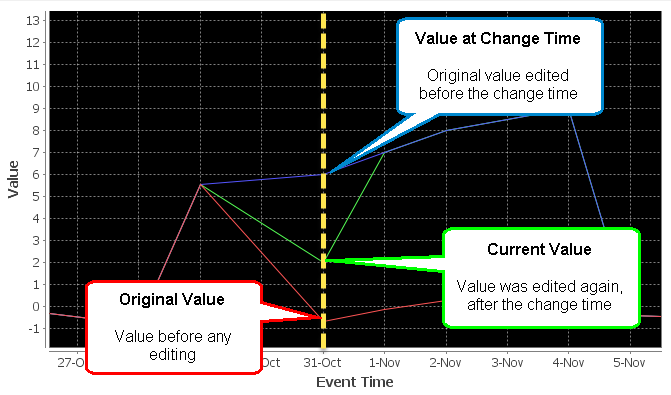Viewing data history for a tag
Use the Data History tool to recreate a snapshot of the historical data record for a tag as it was at a specific date and time (the Change Time). You can view tabulated values, or view the values in a summary graph.
Example
Suppose you imported data for a tag and overwrote some existing historical records. If you view the tag event history in the Site Tags Module, you can see only the event history as it appears now. To view the original values before they were changed, view the data history and choose a Change Time before you performed the data import.
To view the data history for a tag:
- Click
 Data History to open the Data History module.
Data History to open the Data History module. - Click
 Find to enter the search criteria.
Find to enter the search criteria. - Specify the tag whose history you want to view. Use
 Find Tag to search using the Tag Chooser.
Find Tag to search using the Tag Chooser. - Enter the Start Date and the End Date of the period of tag event history that you want to retrieve.
- Enter the Change Time to specify the snapshot date and time for which you want to retrieve the tag event history.
- Click Find to load the tag event history details.
The Data History module loads a table of Tag Event values showing the following values:
| Property | Description |
|---|---|
|
Event Time |
Time and date of the original data event |
|
Original Value |
Data value at the event time and date |
|
Value at Given Time |
Data value at the Change Time including any edits made up to the change time |
|
Current Value |
Data value at the current time including any edits made both before and after the change time. |
Note
Save this data snapshot to a spreadsheet by right-clicking on the table and choosing Export Table to Excel File.
See Exporting Tables for more details.
Viewing data on a summary graph
To view the same data in a summary graph, open the Summary tab. The graph shows the original, current and change time values plotted against the event time and date.
For example, in this graph at the event marked by the yellow dotted line, the original value (red) has been edited both before the Change Time (giving the blue change time value), and again after the change time (giving the green current value).
